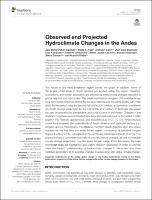Observed and projected hydroclimate changes in the Andes
Resumen
The Andes is the most biodiverse region across the globe. In addition, some of the largest urban areas in South America are located within this region. Therefore, ecosystems and human population are affected by hydroclimate changes reported at global, regional and local scales. This paper summarizes progress of knowledge about long-term trends observed during the last two millennia over the entire Andes, with more detail for the period since the second half of the 20th century, and presents a synthesis of climate change projections by the end of the 21st century. In particular, this paper focuses on temperature, precipitation and surface runoff in the Andes. Changes in the Andean cryosphere are not included here since this particular topic is discussed in other paper in this Frontiers special issue, and elsewhere (e.g. IPCC, 2019b). While previous works have reviewed the hydroclimate of South America and particular sectors (i.e., Amazon and La Plata basins, the Altiplano, Northern South America, etc.) this review includes for the first time the entire Andes region, considering all latitudinal ranges: tropical (North of 27 S), subtropical (27 S37 S) and extratropical (South of 37 S). This paper provides a comprehensive view of past and recent changes, as well as available climate change projections, over the entire Andean range. From this review, the main knowledge gaps are highlighted and urgent research necessities in order to provide more mechanistic understanding of hydroclimate changes in the Andes and more confident projections of its possible changes in association with global climate change.
El ítem tiene asociados los siguientes ficheros de licencia:








